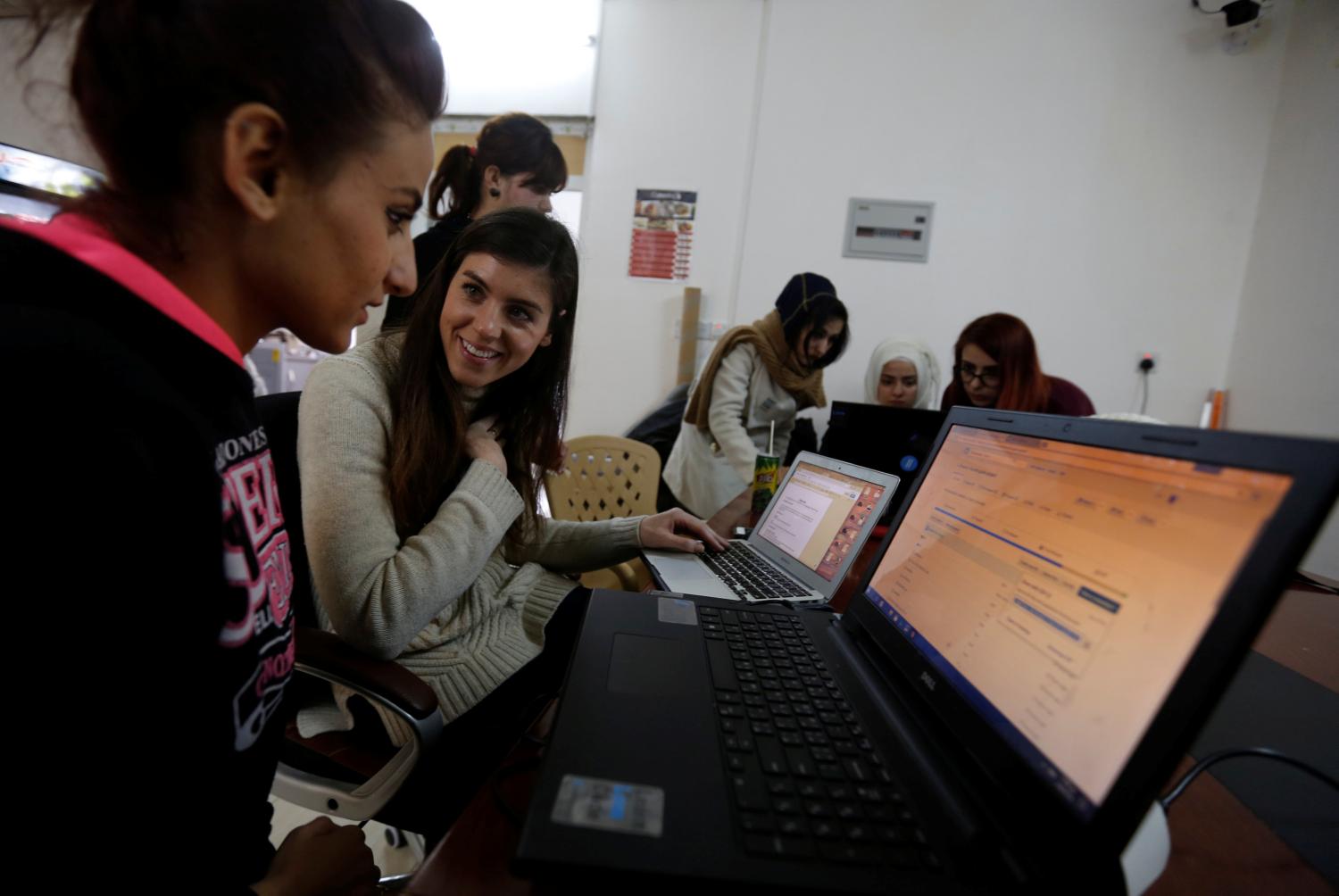The following essay comes from “Meaningful education in times of uncertainty,” a collection of essays from the Center for Universal Education and top thought leaders in the fields of learning, innovation, and technology.
 Achieving the U.N. Sustainable Development Goal 4 for Education will require a rapid increase in the effectiveness of schooling for every child. Policymakers, therefore, face finding a new schooling paradigm that both prepares every individual child for a very dynamic workplace, and doing so at scale.
Achieving the U.N. Sustainable Development Goal 4 for Education will require a rapid increase in the effectiveness of schooling for every child. Policymakers, therefore, face finding a new schooling paradigm that both prepares every individual child for a very dynamic workplace, and doing so at scale.
The current Western model of schooling is neither working well, nor is scalable, and so it is natural that we should turn to technology for a solution. Wherever on the spectrum you are between algorithmic automation of teaching and letting children loose with computers as self-directed learning, it seems remarkable that all these roads lead to teacherless schooling.
There must be a third way that retains the profoundly human endeavor of teaching.
The opportunity is for teachers to deliver a more universal individualized education by being empowered with digital algorithms, not enslaved by them.
It is worth acknowledging that analog algorithms already exist in traditional school classrooms. Teaching to strict lesson plans, to textbooks, to scripts; these are analog teaching algorithms and are now highly replicable in a digital age, largely by machines. They were forged in an industrial era in order to teach content at scale, and dependent on expensive highly educated teachers.
We are now in an era where even highly skilled work is under significant threat from the rapid development of intelligent machines. According to the Oxford Study Group, 35 percent of jobs in the U.K. and 47 percent of the jobs in the U.S. will not exist by 2033. How does a teacher, school leader, or policymaker know, with confidence, what to prioritize if they are to prepare a child for such an uncertain future?
The established model of schooling is not only becoming unsustainable in cost and supply of talented teachers, it will also have to rapidly improve its ability to educate children to higher levels of technical and creative skills. Our schooling systems need to prepare people to effectively compete with machines—or to work effectively alongside them. Can schools use machines to help tackle that challenge?
Bridge International Academies is delivering low-cost private education in some of the poorest countries in the world, at scale and with positive outcomes in literacy and numeracy test scores. Due to their low-costs, their popularity with parents is seen in their growth. They are ruthless in driving down cost through economies of scale and standardized practice. This extends into the classroom where teachers use lesson scripts from tablet computers and managers use the data to monitor the progress of each lesson.
For Bridge, the challenge of scaling primary education quickly is being solved by commissioning experts to design the detailed process of teaching and delivering it through digital algorithms to low-skilled teachers. The reach of a few experts is significantly scaled by a blend of technology and de-skilled teaching. There is, however, currently little clarity on how teachers will grow in their autonomy. They are being programmed like machines with algorithms, so why not replace them with machines that will more reliably follow the algorithm?
At the other extreme, Professor Sugata Mitra is trying to tackle the challenge of learning in places where there are few competent teachers. He is investigating the potential of self-organized learning environments and a question-based curriculum. He has shown that children can teach themselves how to use computers and the internet through shared digital resources. So, as a result, they can effectively acquire knowledge, with adult encouragement and supervision, but no trained teachers. This has not been delivered at anything like the scale of Bridge but it avoids standardization. It embraces self-directed learning, but does it deliver education? Does it “school” children to behave as parents and their communities would want?
This goes to the core question of what we now want from schooling.
Do we want every child to complete schooling and enter adulthood equipped with a canon of knowledge about a broad and balanced curriculum? Should they also have social skills of empathy, communication, and resilience? Do they also need to be creative and skilled in making things as designers, engineers, and performers? What behaviors do we need children to comply with to succeed?
Our whole education system is designed to test individuals against an average ability to recall a standardized curriculum. Those with the best scores go to the best colleges and then get the best jobs. It is a talent sifting machine created during a time when mass employment was low-skilled and choking human potential was sustainable. But it is inadequate in an era when people are competing against machines and need to maximize their uniqueness.
In The End of Average, Todd Rose argues that “today we have the ability to understand individuals and their talents on a level that was not possible before.” His attack on the Taylorist education system is devastating, concluding that “traditional public education systems violate the principles of individuality.”
He advocates genuinely individualized learning, which is beyond personalized learning experiences designed to get learners to pass standardized tests. He wants us to move from Taylorism to a tailored learning experience. His answer is to break up qualifications into credentials, to replace grades with competency-based judgments, and to allow learners more self-direction in their learning.
This would create a flexible infrastructure for the sort of system being explored by Sugata Mitra but retaining a place for teachers. Learners would be free to learn their passions. They could get credit for what they know, what they make, and what they can do. Their credentials become their individual learning “playlist” that needs no qualification wrapper. This, in turn, allows potential employers to search beyond the blunt summation of a single grade and find the more precise mix of competencies they need.
This flexible, individualized system may also be scalable. A range of online and face to face learning resources could be used, including more peer learning. There would be a better continuity of learning experience between the more social learning in early years and self-directed research in higher education. Employers may also find an improvement in the soft skills they crave such as communication, and collaboration—the same human skills that give people a competitive advantage over robots.
What is the role of the teacher in this model? And how can there be confidence that the self-directed learner is pushed to be the best they can be by working hard to realize the potential of their individual talents?
Teachers would remain, but smooth the experience between informal and formal learning. Learners are used to digital devices that have no instructions, that are intuitive. They should expect the same from formal learning, and to have the exploration and discovery we enjoy when we uncover the mysteries for ourselves. This shifts the teacher from being an instructor to more a collaborator and coach.
Michael Fullan and Maria Langworthy argue in A Rich Seam that we need to move teaching from delivery of instructional content to more of a pedagogy of coaching. They identify “a new model learning partnership between and among students and teachers, aiming towards deep learning goals and enabled by pervasive digital access.” Whilst this owes much to the likes of Dewey and Montessori, they suggest that these partnerships are now emerging as a result of the interplay between alienated students, disenfranchised educators, and the perpetual advances of digital technology and tools.
The coaching pedagogy is fully explored by Daniel Coyle in The Talent Code. Music teachers, sports coaches, and other similar roles train by observing performance, analyzing data, and asking the right questions of each individual so that the work is focused on where improvement is needed.
For example, a great tennis player still needs a coach. Andy Murray is a better tennis player today than Ivan Lendl, but Lendl the coach has played a vital part in Murray’s rise to the top through his understanding of the individual. By working on the right parts of Murray’s physical and mental game, and by nurturing the growth mindset popularized by Carol Dweck, his tennis performance has been elite.
This pedagogy could be applied to a range of learning and requires human skills not easily converted to algorithms. If Facebook is having to hire people to tackle the “fake news” problem, rather than using their world leading algorithm writing capability, then we can be confident that interpreting the range of visual, cognitive, and behavioral signals from a learner is still something we need humans to do.
Every school already employs teachers who are familiar with this pedagogy—in sports, the arts, design, and technology. They are familiar with subjective forms of assessment that are vested in the expertise of the assessor to judge the competence of performance and exhibition. At schools like the Apollo School in Pennsylvania, they are developing this to create a very different learner experience across the curriculum.
The opportunity is for teaching to evolve these pedagogies at scale. In order to best coach their pupils and keep workload manageable, they need the assistance of technology to inform their professional judgment.
Rose Luckin and Wayne Holmes argue that artificial intelligence is the new teaching assistant in the classroom. Enhanced data analytics, together with machine learning functionalities, offer the promise of significantly enhancing teachers’ ability to coach each individual’s learning. It also has the potential to capture performance in real-time, releasing time and money currently spent on assessment.
This has implications for teachers wherever they are in the world. Using the digital algorithms behind AI to make previously inconceivable practices possible can transform our chances of rapidly scaling effective universal education. Either we can digitize the algorithms of standardization and scale by de-professionalizing teachers to deliver traditional schooling, or we can develop a new generation of professionals with new pedagogies to wrap teaching around individual learners.
In the modern economy, the current established schooling system is failing too many learners. It is not financially sustainable, teachers are leaving the profession, and child mental health problems are rising. We should not persist with a model that is making our children sick.
A system that believes in, and empowers every child, is possible. It can use latent resources such as personal devices, community infrastructure, and peer assessment. It can make the teaching profession more sustainable by relieving much of the workload pressure of teaching with digital tools and algorithms that can also give teachers insight on their learners, and allow pedagogy to be redefined.
A system that connects learners to their passions can, in turn, connect teachers to the passion of their vocation. Empowered by enslaving the algorithm in the service of the teacher, rather than enslaving the teacher to service the algorithm, we can revive a teaching profession that can rediscover the love—in their practice, in unlocking learning and in helping all individual children grow.
The Brookings Institution is committed to quality, independence, and impact.
We are supported by a diverse array of funders. In line with our values and policies, each Brookings publication represents the sole views of its author(s).





Commentary
Op-edA third way: Algorithms and teacher empowerment for every individual
August 3, 2017